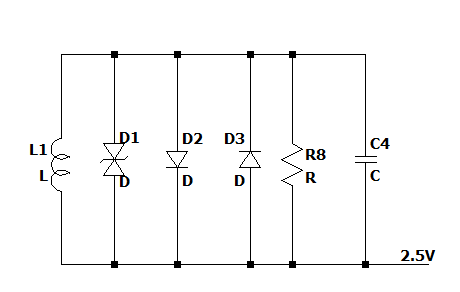How to choose the right clamp diodes for CT overvoltage protection Asked 3 years, 7 months ago Modified 3 years, 7 months ago I have seen back to back diodes and TVS diode (no both at the same time) used for protection in current transformers. In my case, I have a CT signal with a DC offset of 2.5V. The max voltage I will see across the burden resistor is 320 mV (under normal current range). So I would like to protect the rest of the circuit in case of overvoltage. I think that as my signal has a DC offset, then back to back diodes may no be needed, but just one diode. Am I right? Or would a bidirectional TVS fit better? My confusion is because back to back diodes are usually used when the signal swings around zero, but in this case it swings around 2.5V.
 diodesprotectionover-voltage-protection
user115094
Why is your circuit a dead end? –
DKNguyen Apr 6, 2020 at 3:00
diodesprotectionover-voltage-protection
user115094
Why is your circuit a dead end? –
DKNguyen Apr 6, 2020 at 3:00
Answer 1 Sorry, didn't put the rest of the circuit, but the CT output goes to an inverting amplifier, and then to an ADC input. – user115094 Apr 6, 2020 at 3:03 The 2.5V doesn't matter, the diodes only see the 320mV. I think I would use rectifier diodes in series for each direction, so 4 diodes total. You could also use a bridge rectifier and short the output (only 1 component required). The type would depend on the maximum current that the CT can produce. You might also want to put a TVS or other clamp from the output to ground, so as to clamp any capacitively coupled common mode voltage. answered Apr 6, 2020 at 3:15 Spehro Pefhany 383k2121 gold badges328328 silver badges861861 bronze badges Why two diodes in series? Do you think one can get some leakage leaving only a diode? – user115094 Apr 6, 2020 at 3:23 Yes, why two in series? – DKNguyen Apr 6, 2020 at 3:24
- Yes, there will be some leakage. 320mV RMS is 450mV peak. You could sharpen your pencil and evaluate the forward leakage (worst case will be at the maximum ambient temperature). Maybe it's okay, but it seems a bit close to me. – Spehro Pefhany Apr 6, 2020 at 3:50 Ok. If I use 4 diodes then the clamping will be symmetrical. Doesn't it need to be asymmetrical as pointed out by @DKNguyen ? – user115094 Apr 6, 2020 at 4:04
- @Blue_Electronx No, I never said you needed it to be asymmetric. I was just describing how to make it asymmetric. In your case, you want symmetric. I don't see why you would want it to clamp asymmetrically around 2.5V in your applciation – DKNguyen Apr 6, 2020 at 4:05
Answer 2 Just D1, or both D2 and D3 will prevent the voltage from straying too far from 2.5V. No point of having all of them. 320mV is so low I don't think you can find a TVS diode with a low enough reverse breakdown voltage. D2 and D3 clamp in forward bias. D1 clamps in reverse breakdown of one TVS and forward bias of the other (it is just two TVS diodes back-to-back). D2 clamps positive swing. D3 clamps negative swing. Choosing the forward voltage drop of D2 and D3 to be different (or building your own bidirectional TVS by placing two unidirectional TVS diodes with different reverse breakdown voltages back-to-back will result in assymetrical clamping above and below 2.5V.
